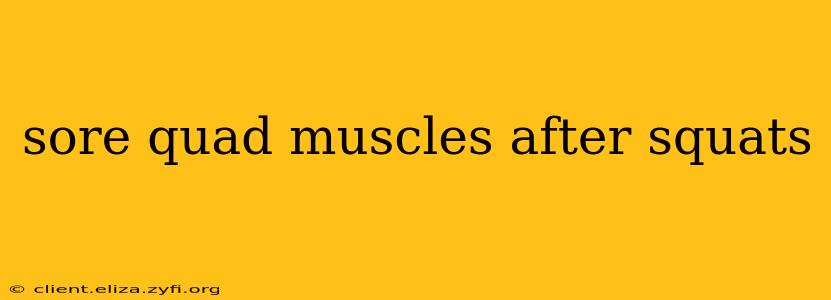Squats are a cornerstone of many fitness routines, building strength and muscle mass in the legs and glutes. However, the intense workout often leaves you with sore quad muscles in the days following a strenuous squat session. This soreness, while often a sign of a productive workout, can be debilitating if not managed properly. This comprehensive guide explores the causes of sore quads after squats, strategies for prevention, and effective recovery methods.
Why Are My Quads Sore After Squats?
The soreness you experience after squats, known as Delayed Onset Muscle Soreness (DOMS), is a result of microscopic muscle tears caused by the intense exercise. These tears are a natural part of the muscle-building process; your body repairs them, making the muscles stronger and more resilient over time. The inflammation associated with this repair process is what causes the pain and stiffness.
How Long Does Quad Soreness From Squats Last?
The duration of quad soreness after squats varies depending on several factors, including your fitness level, the intensity and volume of your workout, and your individual recovery capabilities. Typically, the most intense soreness peaks within 24-72 hours after your squat session, gradually subsiding over the next 3-7 days. However, some individuals may experience lingering discomfort for a longer period.
What Causes Sore Quads After Squats?
Several factors contribute to quad soreness after squats. These include:
- Eccentric Loading: The lowering (eccentric) phase of the squat is particularly demanding on the quadriceps. This is when the muscles are lengthening under tension, placing significant stress on muscle fibers.
- Insufficient Warm-up: An inadequate warm-up leaves your muscles unprepared for the intense demands of squatting, increasing the risk of injury and soreness.
- Improper Form: Incorrect squatting technique puts undue stress on specific muscle groups, leading to disproportionate soreness and potentially injury.
- Overtraining: Squatting too frequently or with excessive weight can overwhelm your muscles, resulting in prolonged and intense soreness.
- Dehydration: Proper hydration is crucial for muscle function. Dehydration can impair muscle performance and increase the risk of injury and subsequent soreness.
- Lack of Rest: Allowing insufficient time for muscle recovery between workout sessions can contribute to persistent soreness and hinder progress.
How Can I Prevent Sore Quads After Squats?
Prevention is always better than cure. Here are several strategies to minimize quad soreness after your squats:
- Proper Warm-up: Begin with 5-10 minutes of light cardio, followed by dynamic stretching exercises like leg swings and torso twists. This prepares your muscles for the workout.
- Perfect Your Form: Focus on maintaining correct form throughout the entire squat movement to ensure even muscle engagement and reduce strain on any single area. Consider working with a trainer to assess and correct your technique.
- Progressive Overload: Gradually increase the weight, reps, or sets over time, allowing your muscles to adapt to the increasing demands. Avoid sudden, drastic increases in workout intensity.
- Adequate Rest and Recovery: Ensure you get enough sleep and allow sufficient time for muscle recovery between squat sessions. Listen to your body and take rest days when needed.
- Hydration: Drink plenty of water throughout the day, especially before, during, and after your workout.
- Nutrition: Consume a balanced diet rich in protein to support muscle repair and growth.
How Can I Treat Sore Quad Muscles After Squats?
If you experience quad soreness, these strategies can help with recovery:
- Rest: Give your muscles a break from strenuous activity. Avoid further intense squatting until the soreness subsides.
- Light Cardio: Gentle low-impact activities like walking or cycling can promote blood flow and aid in recovery.
- Stretching: Static stretches, holding each stretch for 20-30 seconds, can help improve flexibility and reduce muscle tightness. Focus on stretches that target the quadriceps.
- Foam Rolling: This self-massage technique can help to relieve muscle tension and improve blood flow.
- Cold Therapy: Applying ice packs to the affected area for 15-20 minutes at a time can reduce inflammation and pain.
- Heat Therapy: After the initial 24-48 hours, heat therapy (warm bath, heating pad) can help to relax the muscles and improve blood flow.
- Over-the-Counter Pain Relief: Nonsteroidal anti-inflammatory drugs (NSAIDs) like ibuprofen can help to reduce pain and inflammation.
By understanding the causes of quad soreness, implementing preventive measures, and employing effective recovery strategies, you can maximize the benefits of your squat workouts while minimizing discomfort. Remember to listen to your body and adjust your training accordingly. Consistent, mindful training leads to better results and a more enjoyable fitness journey.
